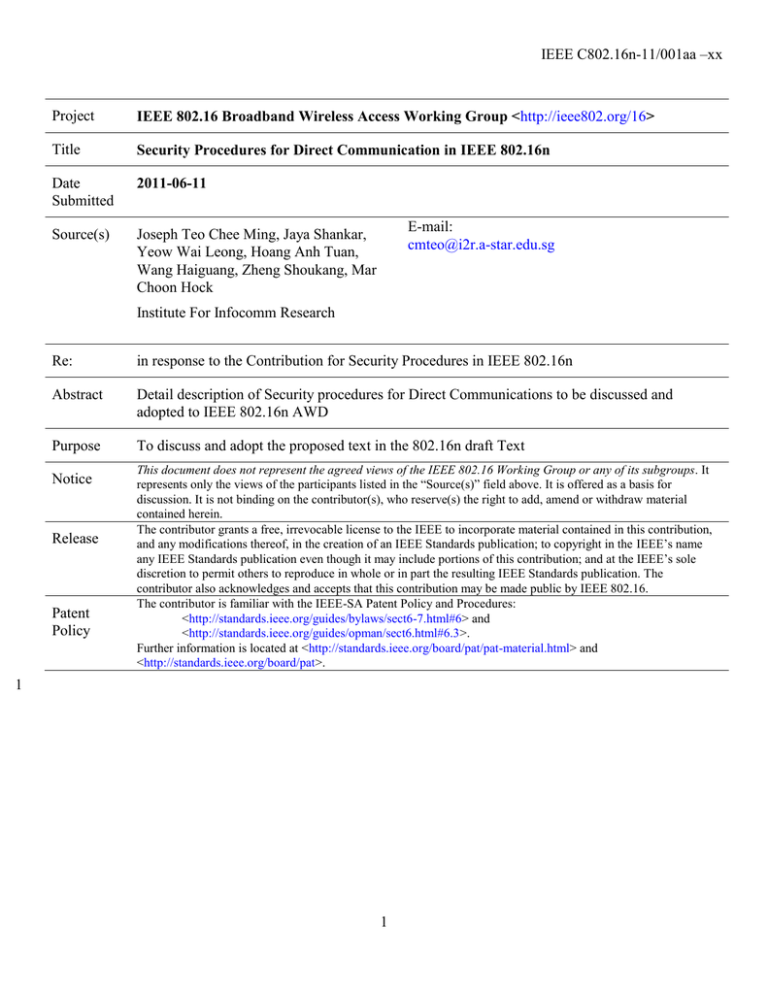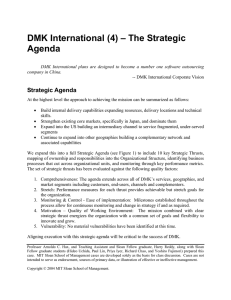IEEE C802.16n-11/001aa –xx Project Title
advertisement

IEEE C802.16n-11/001aa –xx
Project
IEEE 802.16 Broadband Wireless Access Working Group <http://ieee802.org/16>
Title
Security Procedures for Direct Communication in IEEE 802.16n
Date
Submitted
2011-06-11
Source(s)
Joseph Teo Chee Ming, Jaya Shankar,
Yeow Wai Leong, Hoang Anh Tuan,
Wang Haiguang, Zheng Shoukang, Mar
Choon Hock
E-mail:
cmteo@i2r.a-star.edu.sg
Institute For Infocomm Research
Re:
in response to the Contribution for Security Procedures in IEEE 802.16n
Abstract
Detail description of Security procedures for Direct Communications to be discussed and
adopted to IEEE 802.16n AWD
Purpose
To discuss and adopt the proposed text in the 802.16n draft Text
Notice
Release
Patent
Policy
This document does not represent the agreed views of the IEEE 802.16 Working Group or any of its subgroups. It
represents only the views of the participants listed in the “Source(s)” field above. It is offered as a basis for
discussion. It is not binding on the contributor(s), who reserve(s) the right to add, amend or withdraw material
contained herein.
The contributor grants a free, irrevocable license to the IEEE to incorporate material contained in this contribution,
and any modifications thereof, in the creation of an IEEE Standards publication; to copyright in the IEEE’s name
any IEEE Standards publication even though it may include portions of this contribution; and at the IEEE’s sole
discretion to permit others to reproduce in whole or in part the resulting IEEE Standards publication. The
contributor also acknowledges and accepts that this contribution may be made public by IEEE 802.16.
The contributor is familiar with the IEEE-SA Patent Policy and Procedures:
<http://standards.ieee.org/guides/bylaws/sect6-7.html#6> and
<http://standards.ieee.org/guides/opman/sect6.html#6.3>.
Further information is located at <http://standards.ieee.org/board/pat/pat-material.html> and
<http://standards.ieee.org/board/pat>.
1
1
IEEE C802.16n-11/001aa –xx
1
2
3
4
5
6
Security Procedure for Direct Communication in IEEE 802.16n
Joseph Teo Chee Ming, Jaya Shankar, Yeow Wai Leong, Hoang Anh Tuan, Wang Haiguang, Zheng
Shoukang, Mar Choon Hock
Institute for Infocomm Research
7
8
9
10
11
12
Introduction
This contribution contains the detailed proposed text from Security Procedures for Secure Direct
Communications in IEEE 802.16n. It is to be proposed to placed into the AWD text for the IEEE 802.16n
GridMAN standards. This contribution covers both Section 17.2.10 Security (for 802.16e) and also Section
17.3.10 Security (for 802.16m) as the Security Procedure is meant for both 16e and 16m standard.
13
14
15
16
17
18
19
20
21
22
It should be noted that:
1. Proposed texts are placed in the Section they address. If the text in the contribution addresses more
than one section, then the text is split and placed under the appropriate Section numbers (or categories).
2. All proposed texts from different contributions that address a particular section are together.
3. Existing Section numbers are in black color with a bold face.
4. Existing text are colored black
5. All proposed sections are colored blue with an underline and bold face.
6. All proposed text are initially colored blue with an underline.
23
[-------------------------------------------------Begin of Text Proposal----------------------------------------------------]
24
25
17.2.10 Security
26
27
28
29
30
31
32
33
34
35
36
17.2.10.1 Security Procedure for Direct Communication Data Security
17.2.10.1.1 Security Procedure for BS-coordinated Secure Direct Communication
17.2.10.1.1.a BS-coordinated Key Management Procedure for Secure Direct Communication
In order to support BS-coordinated secure direct communication, the security procedure described in this
subsection shall be executed between HR-MS, HR-BS, Authenticator, and AAA Server. Upon successful
2
IEEE C802.16n-11/001aa –xx
1
2
3
completion of the security procedure, HR-MSs received the security key from the HR-BS and use this security
key for secure direct communication between/among HR-MSs. This security key may be used as the preestablished shared key for secure direct communications in Section 17.2.10.1.1.1.1.
4
5
6
7
8
The HR-BS/Authenticator is used to denote that the HR-BS may pass the messages to the AAA-server via the
Authenticator for verification and the AAA-server may compute the direct communication security key DMK
and send it to the HR-BS via the Authenticator. The flow diagram is shown in Figure AAA while the flow chart
is shown in Figure BBB.
9
10
The BS-coordinated security procedure includes the following steps:
11
12
13
14
15
16
17
18
19
20
21
22
Step 1: Once it is determined that secure direct communications is allowed between HR-MS1 and HR-MS2,
HR-BS generates the security key DMK, selects NHR-BS and encrypts EHR-MS1_KEK(DMK, key_lifetime, HRMS1Addr, HR-MS2Addr) and computes θHR-BS = MACCMAC1(“DC_REPLY_OK_BS”|THR-BS|NHR-BS|EHRMS1_KEK(DMK, key_lifetime, HR-MS1Addr, HR-MS2Addr)|HR-MS1Addr|HR-MS2Addr) and sends KeyTransfer-MSG#1 message to HR-MS1, where Key-Transfer-MSG#1 = “DC_REPLY_OK_BS”|THR-BS|NHRBS|EHR-MS1_KEK(DMK, key_lifetime, HR-MS1Addr, HR-MS2Addr)|HR-MS1Addr|HR-MS2Addr|θHR-BS. HR-BS
also encrypts EHR-MS2_KEK(DMK, key_lifetime, HR-MS2Addr, HR-MS1Addr) and computes θHR-BS = MAC
CMAC2(“DC_REPLY_OK_BS”|THR-BS|NHR-BS|EHR-MS2_KEK(DMK, key_lifetime, HR-MS2Addr, HRMS1Addr)|HR-MS2Addr|HR-MS1Addr) and sends Key-Transfer-MSG#2 message to HR-MS2, where KeyTransfer-MSG#2 = “DC_REPLY_OK_BS”|THR-BS|NHR-BS|EHR-MS2_KEK(DMK, key_lifetime, HR-MS2Addr, HRMS1Addr)|HR-MS2Addr|HR-MS1Addr|θHR-BS.
23
24
25
26
27
Step 2a: If HR-MS1 received Key-Transfer-MSG#1 message from HR-BS, HR-MS1 first checks THR-BS, NHR-BS
for freshness and θHR-BS for message authentication. If the verifications fail, then HR-MS1 shall ignore KeyTransfer-MSG#1 message. If the verifications are correct, then HR-MS1 decrypts EHR-MS1_KEK(DMK,
key_lifetime, HR-MS1Addr, HR-MS2Addr) and obtains the security key DMK and its lifetime key_lifetime.
28
29
30
31
32
Step 2b: Upon receiving the Key-Transfer-MSG#2 message, HR-MS2 first checks THR-BS, NHR-BS for freshness
and θHR-BS for message authentication. If the verifications fail, HR-MS2 shall ignore the Key-Transfer-MSG#2
message. If the verifications are correct, then HR-MS2 decrypts EHR-MS2_KEK(DMK, key_lifetime, HRMS2Addr, HR-MS1Addr) and obtains the security key DMK and its lifetime key_lifetime.
33
3
IEEE C802.16n-11/001aa –xx
HR-BS/
Authenticator
HR-MS1
HR-MS2
Key-Transfer-MSG#1(DMK)
Key-Transfer-MSG#2 (DMK)
1
2
Figure AAA: Flow Diagram of Authentication and Key Establishment of Network
Aided Direct Communication scenario.
3
4
5
6
17.2.10.1.1.a.a Message Type
7
8
Table aaa – Message Type
Code
a
b
Message Type
Key-Transfer-MSG#1
Key-Transfer-MSG#2
MAC control message name
AAI-PKM-RSP
AAI-PKM-RSP
9
10
11
12
17.2.10.1.1.a.b Message Attributes
Table eee – Key-Transfer-MSG#1 message attribute
Attribute
“DC_REPLY_OK_BS”
THR-BS
Contents
HR-BS response to HR-MS1 that HR-MS2 accepted
direct communications
Timestamp generated by HR-BS
NHR-BS
EHR-MS1_KEK(DMK, key_lifetime, HRMS1Addr, HR-MS2Addr)
HR-MS1Addr
Freshly generated random number of 64bits by HR-BS
Encryption of DMK, key lifetime by HR-BS using HRMS1's KEK
Address of HR-MS1
HR-MS2Addr
θHR-BS
Address of HR-MS2
Message digest calculated using CMAC key by HR-BS
4
IEEE C802.16n-11/001aa –xx
1
2
Table fff – Key-Transfer-MSG#2 message attribute
Attribute
“DC_REPLY_OK_BS”
THR-BS
Contents
HR-BS response to HR-MS1 that HR-MS2 rejected
direct communications
Timestamp generated by HR-BS
NHR-BS
EHR-MS2_KEK(DMK, key_lifetime, HRMS2Addr, HR-MS1Addr)
HR-MS2Addr
Nonce generated by HR-BS
Encryption of DMK, key lifetime by HR-BS using HRMS2's KEK
Address of HR-MS2
HR-MS1Addr
θHR-BS
Address of HR-MS1
Message digest calculated using CMAC key by HR-BS
3
4
5
6
17.2.10.1.1.1b Autonomous Mutual Authentication of HR-MS and data security
for Direct Communications
7
8
17.2.10.1.1.1b.1 Secure direct communication using pre-established shared key
9
10
In order to support secure direct communication between two or among more HR-MSs, pre-established shared
key is used.
11
The pre-established shared key is established prior to the start of this direct communications.
12
13
The pre-established shared key may be established using the procedure mentioned in Section 17.2.10.1.1.
14
15
16
17
18
The key agreement handshake procedure described below shall be used for HR-MSs to mutually authenticate
themselves (without access to a security server) using the pre-established shared key and to derive data security
keys for secure direct communications. Figure CCC shows the flow diagram while Figure DDD shows the flow
chart for this scenario.
19
20
The key agreement handshake procedure using pre-established shared key includes the following steps:
21
22
23
24
Step 1: HR-MS1 selects nonce NHR-MS1 and uses the pre-established shared key DMK to compute DAK,
DCMAC key and θHR-MS1 = MACDCMAC(N HR-MS1|DMK_Sequence_No|DAKID|Key_lifetime). Finally, HR-MS1
sends the DirectComms_KeyAgreement_MSG_#1 message to HR-MS2, where
5
IEEE C802.16n-11/001aa –xx
1
DirectComms_KeyAgreement_MSG_#1 = NHR-MS1|DMK_Sequence_No|DAKID|Key_lifetime|θHR-MS1.
2
3
4
5
6
7
8
9
10
Step 2: HR-MS2 first verifies the received nonce is fresh and uses the pre-established shared key DMK to
compute DAK =Dot16KDF (DMK, HR-MS1Addr|HR-MS2Addr|”DAK”, 160), the DCMAC =
Dot16KDF(DAK, “DCMAC_KEYS”, 128) and uses DCMAC key to checks θHR-MS1. If the verification fails,
HR-MS2 shall ignore the DirectComms_KeyAgreement_MSG_#1 message. If the verification is correct, HRMS2 selects NHR-MS2 and computes θHR-MS2 = MACDCMAC(N HR-MS1|N HRMS2|DAKID|DMK_Sequence_No|DC_Security_Parameters). Finally, HR-MS2 sends
DirectComms_KeyAgreement_MSG_#2 message to HR-MS1, where DirectComms_KeyAgreement_MSG_#2
= N HR-MS1|N HR-MS2|DAKID|DMK_Sequence_No|DC_Security_Parameters|θHR-MS2.
11
12
13
14
15
16
17
18
19
20
21
22
Step 3: HR-MS1 receives the DirectComms_KeyAgreement_MSG_#2 message from HR-MS2 and checks the
received nonces for freshness and also checks DAKID and θHR-MS2. If the verifications fail, HR-MS1 shall
ignore the DirectComms_KeyAgreement_MSG_#2 message. If the verifications are correct, HR-MS1 computes
θHR-MS1' = MACDCMAC(NHR-MS1|N HR-MS2|DMK_Sequence_No|DC_SAID|DC_Security_Parameters). Finally, HRMS1 sends DirectComms_KeyAgreement_MSG_#3 message to HR-MS2, where
DirectComms_KeyAgreement_MSG_#3 = NHR-MS1|N HR-MS2|DMK_Sequence_No|DC_SAID|
DC_Security_Parameters|θHR-MS1'. If HR-MS1 does not receive DirectComms_KeyAgreement_MSG_#2
message from HR-MS2 within DirectComms_KeyAgreement_MSG_#1 Timeout, it shall resend the
DirectComms_KeyAgreement_MSG_#1 message up to DirectComms_KeyAgreement_MSG_#1 MaxResends
times. If HR-MS1 reaches its maximum number of resends, it shall initiate another authentication or drop the
request.
23
24
25
26
27
28
29
30
31
32
33
Step 4: Upon receiving the DirectComms_KeyAgreement_MSG_#3 message, HR-MS2 checks the received
nonces for freshness and θHR-MS1'. If the verifications are invalid, then HR-MS2 shall ignore the
DirectComms_KeyAgreement_MSG_#3 message. If the verifications are correct, HR-MS2 applies the
negotiated security parameters. Otherwise, if θHR-MS1' is invalid, then HR-MS2 shall ignore the
DirectComms_KeyAgreement_MSG_#3 message. If HR-MS2 does not receive
DirectComms_KeyAgreement_MSG_#3 message from HR-MS1 within
DirectComms_KeyAgreement_MSG_#2 Timeout, it shall resend the DirectComms_KeyAgreement_MSG_#2
message up to DirectComms_KeyAgreement_MSG_#2 MaxResends times. If HR-MS2 reaches its maximum
number of resends, it shall initiate another authentication or drop the request. HR-MS1 and HR-MS2 can now
derive DTEK = DOT16KDF(DAK, “DTEK_KEY”, 128) and commence secure direct communications.
34
6
IEEE C802.16n-11/001aa –xx
1
2
Figure CCC: Flow Diagram of Authentication and Key Establishment of Direct
Communication without Infrastructure (Pre-shared key case).
7
IEEE C802.16n-11/001aa –xx
HR-MS1 selects its nonce and uses the pre-shared
DMK to compute DAK and DCMAC key. HR-MS1 then
computes the CMAC tuple and sends
DirectComms_KeyAgreement_MSG_#1 message to
HR-MS2.
HR-MS2 verifies the received CMAC tuple. If the
verification is correct, HR-MS2 generates its
nonce and uses the pre-shared DMK to compute
DAK and DCMAC key. HR-MS2 then computes
the CMAC tuple and sends
DirectComms_KeyAgreement_MSG_#2
message to HR-MS1.
HR-MS1 verifies the received CMAC tuple and checks
the DAKID. If the verifications are correct, then HRMS1 computes its new CMAC tuple and sends
DirectComms_KeyAgreement_MSG_#3 message to
HR-MS2.
1
HR-MS2 receives the above message and
verifies the CMAC tuple. If the verification is
correct, then HR- MS2 confirms that HR-MS1
has computed the correct keys and both HR-MS1
and HR-MS2 can now derive DTEK and
commence secure direct communications.
2
3
Figure DDD: Flow Chart of Pre-shared key-based Autonomous Direct Communication
Authentication and Key Establishment Security Procedure.
4
5
8
IEEE C802.16n-11/001aa –xx
1
2
3
17.2.10.1.1.b.1.a Message Type
Table aaa – DC_Request_MSG#1 message attribute
Code
Message Type
DirectComms_KeyAgreement_MSG #1
DirectComms_KeyAgreement_MSG #2
MAC control message name
AAI-PKM-RSP
AAI-PKM-REQ
DirectComms_KeyAgreement_MSG #3
AAI-PKM-RSP
4
5
6
17.2.10.1.1.b.1.b Message Attributes
7
Table ggg – DirectComms_KeyAgreement_MSG_#1 message attribute
Attribute
DMK_Sequence_No
Contents
Freshly generated random number of 64bits by HRMS1
new DMK sequence number
DAKID
identifies the direct communications authorization key
Key_lifetime
DMK key lifetime
θHR-MS1
Message digest calculated using DCMAC key
NHR-MS1
8
9
Table hhh – DirectComms_KeyAgreement_MSG_#2 message attribute
Attribute
DAKID
Contents
Nonce generated by HR-MS1 in
DirectComms_KeyAgreement_MSG_#1 message
Freshly generated random number of 64bits by HRMS2
identifies the direct communications authorization key
DMK_Sequence_No
new DMK sequence number
DC_Security_Parameters
The requesting HR-MS's security capabilities
θHR-MS2
Message digest calculated using DCMAC key
NHR-MS1
N HR-MS2
10
11
12
13
14
15
16
9
IEEE C802.16n-11/001aa –xx
1
Table iii – DirectComms_KeyAgreement_MSG_#3 message attribute
Attribute
DC_Security_Parameters
Contents
Nonce generated by HR-MS1 in
DirectComms_KeyAgreement_MSG_#1 message
Nonce generated by HR-MS1 in
DirectComms_KeyAgreement_MSG_#2 message
new DMK sequence number
identifies the direct communications authorization key
for protecting this message
The supporting HR-MS's security capabilities
θHR-MS1'
Message digest calculated using DCMAC key
NHR-MS1
N HR-MS2
DMK_Sequence_No
DC_SAID
2
3
4
5
6
17.2.10.1.1.1b.2 Secure direct communication using Public Key Infrastructure
7
8
Each HR-MS has a public/private key pair and digital certificate (e.g. X.509) issued by a certification authority
for mutual authentication and key exchange prior to the start of this direct communications.
9
10
11
12
13
The key agreement handshake procedure described below shall be used for HR-MSs to mutually authenticate
themselves (without access to a security server) using Public Key Infrastructure and to derive data security keys
for secure direct communications. The flow diagram for this scenario is depicted in Figure EEE and the Flow
Chart for this scenario is shown in Figure FFF.
When pre-established shared key is not used for direct communication, Public Key Infrastructure shall be used.
14
15
The key agreement handshake procedure using Public Key Infrastructure includes the following steps:
16
17
18
19
20
Step 1: HR-MS1 first generates nonce NHR-MS1. Next, HR-MS1 computes the signature σHR-MS1 = SIGN(T HRMS1|N HR-MS1|HR-MS2Addr|HR-MS1Addr) and sends DirectComms_KeyAgreement_MSG_#1 message to HRMS2, where DirectComms_KeyAgreement_MSG_#1 = T HR-MS1|NHR-MS1|HR-MS2Addr|HR-MS1Addr|σHRMS1|Cert(HR-MS1).
21
22
23
24
25
26
27
28
Step 2: HR-MS2 first verifies the received timestamp and nonce for freshness and the certificate Cert(HR-MS1)
and signature σHR-MS1. If the verifications fail, then HR-MS2 ignores the
DirectComms_KeyAgreement_MSG_#1 message. If the verifications are correct, then HR-MS2 generates
nonce NHR-MS2 and security key DMK and computes DAK =Dot16KDF ( DMK, HR-MS1Addr|HR-MS2Addr|
“DAK”, 160) and the DCMAC = Dot16KDF(DAK, “DCMAC_KEYS”, 128) and θHR-MS2 = MACDCMAC(N HRMS2|NHR-MS1|HR-MS2Addr|HR-MS1Addr). HR-MS2 then uses HR-MS1's public key to encrypt and obtain EHRMS1_PK(DMK, key_lifetime, HR-MS1Addr, HR-MS2Addr). Finally, HR-MS2 computes signature σHR-MS2 =
10
IEEE C802.16n-11/001aa –xx
1
2
3
4
SIGN(THR-MS2|NHR-MS2|HR-MS1Addr|HR-MS2Addr|NHR-MS1|EHR-MS1_PK(DMK, key_lifetime, HR-MS1Addr,
HR-MS2Addr)|θHR-MS2) and sends DirectComms_KeyAgreement_MSG_#2 message to HR-MS1, where
DirectComms_KeyAgreement_MSG_#2 = THR-MS2|NHR-MS2|HR-MS1Addr|HR-MS2Addr|NHR-MS1|EHRMS1_PK(DMK, key_lifetime, HR-MS1Addr, HR-MS2Addr)|θHR-MS2|σHR-MS2|Cert({HR-MS2).
5
6
7
8
9
10
11
12
13
14
15
16
17
18
Step 3: HR-MS1 first verifies the received timestamp and nonces for freshness and the certificate Cert(HRMS2) and signature σHR-MS2. If the verification is invalid, then HR-MS1 ignores the
DirectComms_KeyAgreement_MSG_#2 message. If the verifications are correct, then HR-MS1 decrypts EHRMS1_PK(DMK, key_lifetime, HR-MS1Addr, HR-MS2Addr) and obtains security key DMK and key_lifetime.
Next, HR-MS1 computes DAK and DCMAC and verifies θHR-MS2. If the verification is invalid, then HR-MS1
ignores the DirectComms_KeyAgreement_MSG_#2 message. If the verification is correct, then HR-MS1
computes θHR-MS1 = MACDCMAC(N HR-MS1|N HR-MS2|HR-MS1Addr|HR-MS2Addr) and sends
DirectComms_KeyAgreement_MSG_#3 message to HR-MS2, where DirectComms_KeyAgreement_MSG_#3
= NHR-MS2|HR-MS2Addr|HR-MS1Addr| θHR-MS1. If HR-MS1 does not receive
DirectComms_KeyAgreement_MSG_#2 message from HR-MS2 within
DirectComms_KeyAgreement_MSG_#1 Timeout, it shall resend the DirectComms_KeyAgreement_MSG_#1
message up to DirectComms_KeyAgreement_MSG_#1 MaxResends times. If HR-MS1 reaches its maximum
number of resends, it shall initiate another authentication or drop the request.
19
20
21
22
23
24
25
26
27
28
Step 4: HR-MS2 receives the DirectComms_KeyAgreement_MSG_#3 message and verifies received nonce and
the CMAC tuple. If the verification fails, then HR-MS2 ignores DirectComms_KeyAgreement_MSG_#3
message. If the verification is correct, then HR-MS2 confirms that HR-MS1 has computed the correct keys and
commence secure direct communications. If HR-MS2 does not receive DirectComms_KeyAgreement_MSG_#3
message from HR-MS1 within DirectComms_KeyAgreement_MSG_#2 Timeout, it shall resend the
DirectComms_KeyAgreement_MSG_#2 message up to DirectComms_KeyAgreement_MSG_#2 MaxResends
times. If HR-MS2 reaches its maximum number of resends, it shall initiate another authentication or drop the
request. HR-MS1 and HR-MS2 can now derive DTEK = DOT16KDF(DAK, “DTEK_KEY”, 128) and
commence secure direct communications.
29
30
11
IEEE C802.16n-11/001aa –xx
1
2 Figure EEE: Flow Diagram of Authentication and Key Establishment of Direct
3 Communication without Infrastructure (HR-MS becomes HR-BS*case).
4
12
IEEE C802.16n-11/001aa –xx
HR-MS1 sends a
DirectComms_KeyAgreement_MSG_#1
message to HR-MS2 to request for a direct
communication authentication and key
establishment. The message contains a
nonce, signature generated by HR-MS1,
HR-MS1 and HR-MS2 addresses and HRMS1’s digital certificate.
HR-MS2 verifies the received certificate and
signature. If the verification is correct, HR-MS2
generates its nonce and DMK. Next, HR-MS2
computes DAK, DCMAC key and the CMAC
tuple of the message. HR-MS2 then uses the
public key of HR-MS1 to encrypt the DMK.
Finally, HR-MS2 computes the signature and
sends DirectComms_KeyAgreement_MSG_#2
message to HR-MS1. The message also
contains HR-MS2’s digital certificate.
HR-MS1 verifies the received certificate and signature.
If the verification is correct, then HR-MS1 decrypts the
received encrypted message and obtains DMK. Next,
HR-MS1 computes DAK and DCMAC key and verifies
the received CMAC tuple. If the verification is correct,
then HR-MS1 computes its CMAC tuple and sends
DirectComms_KeyAgreement_MSG_#3 message to
HR-MS2.
HR-MS2 receives the above message and
verifies the CMAC tuple. If the verification is
correct, then HR-MS2 confirms that HR-MS1 has
computed the correct keys and both HR-MS1
and HR-MS2 derives DTEK and commence
secure direct communications.
1
2
3
Figure FFF: Flow Chart of PKI-based Autonomous Direct Communication
Authentication and Key Establishment Security Procedure.
13
IEEE C802.16n-11/001aa –xx
1
2
3
17.2.10.1.1.b.2.a Message Type
Table aaa – DC_Request_MSG#1 message attribute
Code
Message Type
DirectComms_KeyAgreement_MSG #1
DirectComms_KeyAgreement_MSG #2
MAC control message name
AAI-PKM-RSP
AAI-PKM-REQ
DirectComms_KeyAgreement_MSG #3
AAI-PKM-RSP
4
5
6
7
17.2.10.1.1.b.2.b Message Attribute
8
Table jjj – DirectComms_KeyAgreement_MSG_#1 message attribute
Attribute
T HR-MS1
NHR-MS1
HR-MS2Addr
HR-MS1Addr
Contents
Timestamp generated by HR-MS1
Freshly generated random number of 64bits by HRMS1
Address of HR-MS2
Address of HR-MS1
Signature of message generated by HR-MS1 using its
RSA private key
Digital certificate of HR-MS1
σHR-MS1
Cert(HR-MS1)
9
10
11
Table kkk – DirectComms_KeyAgreement_MSG_#2 message attribute
Attribute
THR-MS2
NHR-MS2
HR-MS1Addr
HR-MS2Addr
NHR-MS1
EHR-MS1_PK(DMK, key_lifetime, HRMS1Addr, HR-MS2Addr)
Contents
Timestamp generated by HR-MS2
Freshly generated random number of 64bits by HRMS2
Address of HR-MS1
Address of HR-MS2
Nonce generated by HR-MS1 in
DirectComms_KeyAgreement_MSG_#1 message
Public key encryption using HR-MS1's Public key
where DMK = DirectComms
Master Key generated by HR-MS and key_lifetime =
lifetime of DMK
14
IEEE C802.16n-11/001aa –xx
Message digest calculated using DCMAC key by HRMS2
Signature of message generated by HR-MS2 using its
RSA private key
Digital certificate of HR-MS2
θHR-MS2
σHR-MS2
Cert(HR-MS2).
1
2
3
Table lll – DirectComms_KeyAgreement_MSG_#3 message attribute
Attribute
NHR-MS2
HR-MS2Addr
HR-MS1Addr
θHR-MS1
Contents
Nonce generated by HR-MS2 in
DirectComms\_KeyAgreement\_MSG\_\#2 message
Address of HR-MS2
Address of HR-MS1
Message digest calculated using DCMAC key by HRMS1
4
5
6
7
8
9
10
11
17.2.10.1.2 Security Procedure for Secure talk-around Direct Communication
using dedicated resource
In order to support secure direct communication between two or among more HR-MSs, pre-established shared
key is used.
12
13
14
15
The key agreement handshake procedure described in Section 17.2.10.1.1.b.1 may be used for HR-MSs to
mutually authenticate themselves using the pre-established shared key and to derive data security keys for secure
talk-around direct communications.
16
17
18
19
20
17.2.10.1.x Security Context for Direct Communication Security
The direct communciations security context describes the set of parameters that links the direct communication
security keys for secure secure direct communications.
21
22
23
24
17.2.10.1.x.a DMK context
The DMK context includes all parameters associate with the DMK. This context is created when the DMK is
15
IEEE C802.16n-11/001aa –xx
1
derived.
2
The DMK context is described in Table xxx.
3
4
Table xxx – The DMK context
Parameter
Size (bit)
DMK
160
DMK SN
4
DMK Lifetime
DAK_COUNT
32
16
Usage
Multicast Master Key shared by HR-BS and HR-MSs in a
multicast group
DMK sequence number
MMK Lifetime
Counter to ensure freshness of computed CMAC key and
prevent replay attacks.
5
6
7
8
9
10
17.2.10.1.x.b DAK context
The DAK context includes all parameters associate with the DAK. This context is created whenever a new DAK
is derived. This context shall be deleted when the DAK is not in used.
The DAK context is described in Table yyy.
11
12
Table xxx – The DAK context
Parameter
Size (bit)
DAK
160
DAK Lifetime
DAKID
32
64
DCMAC_KEY
128
DCMAC_PN
24
DAK_COUNT
16
Usage
Direct Communications Authentication Key derived from
DMK.
DAK Lifetime
Identifies the DAK key.
Key which is used for signing Direct Communications MAC
control messages.
Used to avoid multicast replay attack on the control
connection. The initial value of DCMAC_PN is zero.
Counter to ensure freshness of computed CMAC key and
prevent replay attacks.
13
14
15
17.2.10.1.x.c DSA context
16
17
The DSA context is the set of parameters managed by each DSA in order to ensure DTEK management and
usage in a secure way for secure direct communications.
18
16
IEEE C802.16n-11/001aa –xx
1
The DSA holds the DTEK context and additional information that belongs to the DSA itself.
2
3
4
17.2.10.1.x.d DTEK context
The DTEK context includes all parameters of the DTEK and is described in Table zzz.
5
6
Table zzz – The DTEK context
Parameter
DTEK
Size (bit)
128
DMK SN
4
Usage
Key used for encryption or decryption of direct
communications messages
DMK sequence number
COUNTER_DTEK
16
The counter used to derive this DTEK
DTEK lifetime
DTEK_PN
32
22
DTEK lifetime=DMK lifetime
The PN used for encrypting multicast packets. After each
Multicast MAC PDU transmission, the value shall be
increased by 1. (0x000000-0x1FFFFF)
7
8
9
10
17.2.10.1.x.e DSA context
11
The DSA context is described in Table aaa.
12
Table aaa – The DSA context
Parameter
Size (bit)
DSAID
8
Usage
The identifier of this DSA, which decribes the applied
encryption/decryption method and DTEK contexts.
DTEK context
Sizeof(DTE
K context)
DTEK context for encryption and decryption
13
14
15
16
17.2.10.1.y Key Derivation
17
18
The key hierarchy defines what keys are present in the system for secure direct communication and how the
keys are generated.
19
20
17.2.10.1.y.a DMK Derivation
17
IEEE C802.16n-11/001aa –xx
1
2
3
The DMK is the security key/pre-established shared key that is randomly generated by HR-BS or HR-MS or a
network entity (e.g. an AAA Server etc). The DMK is a 160-bit key.
4
5
The DMK may be used as a source for keying materials required by upper layers.
6
7
The DMK is used to derive the Direct Communication Authentication Key (DAK).
8
9
17.2.10.1.y.b DAK Derivation
10
11
12
DAK is derived from DMK and belongs to a pair of HR-MSs. The DAK is used for Direct Communications in
the event of failure in the backbone.
13
14
The DAK derivation is as follows:
15
DAK =Dot16KDF (DMK, HR-MS1Addr|HR-MS2Addr|”DAK”, 160)
16
where: HR-MS1Addr and HR-MS2Addr are the addresses of HR-MS1 and HR-MS2 respectively.
17
18
The DCMAC-DTEK prekey is derived from DAK and is used to derive other keys:
19
Direct Communication Cipher-based Message Authentication Code (DCMAC) key
20
Direct Communication Traffic Encryption (DTEK) Key
21
22
The DCMAC-DTEK prekey derivation is done as follows:
23
DCMAC-DTEK prekey = Dot16KDF (DAK, DAK_COUNT|”DCMAC-DTEK prekey”, 160)
24
25
17.2.10.1.y.c DCMAC Key Derivation
26
27
28
DCMAC key is derived from DAK and used for message authentication for the messages sent during direct
communications.
29
DCMAC key is derived as follows:
30
DCMAC key = Dot16KDF(DCMAC-DTEK prekey, “DCMAC_KEYS”, 128)
31
32
33
18
IEEE C802.16n-11/001aa –xx
1
17.2.10.1.y.d DTEK Derivation
2
3
DTEK is the transport encryption key used to encrypt data in direct communications.
4
DTEK is derived as follows:
5
DTEK = Dot16KDF(DCMAC-DTEK prekey, DSAID|COUNTER_DTEK|”DTEK_KEY”, 128)
6
Where
7
SAID is the security association to which the TEK belongs.
8
9
10
COUNTER_DTEK is a counter used to derive different TEKs for the same SAID, the value of the counter is
changed everytime a new DTEK needs to be derived within the same AK and AK_COUNT pair is valid.
Everytime a new DCMAC-DTEK prekey is derived, this counter is reset.
11
17.3.10 Security
12
13
14
15
16
17
18
19
20
21
22
23
17.3.10.1 Security Procedure for Direct Communication Data Security
17.3.10.1.1 Security Procedure for BS-coordinated Secure Direct Communication
Refer to Section 17.2.10.1.1.
17.3.10.1.2 Security Procedure for Secure talk-around Direct Communication
using dedicated resource
Refer to Section 17.2.10.1.2.
24
25
26
27
17.3.10.1.x Security Context for Direct Communication Security
Refer to Section 17.2.10.1.x
28
29
30
17.3.10.1.y Key Derivation
31
Refer to Section 17.2.10.1.y
32
33
34
[-------------------------------------------------End of Text Proposal----------------------------------------------------]
19





